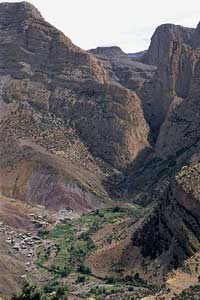
The village of Taghia, which sits at the confluence of the Akka n?Tazarte, Akka n?Taghia and Akka n?Kandate Canyons, High Atlas Mountains, Morocco. Each of the canyons is ten kilometers long, 200 to 700 meters deep and sometimes as little as two meters wide; though the rock is excellent, few routes have been established in the area to date.
[Photo] Maurizio Oviglia
Taghia, a little village on the northern side of the Central Atlas Mountains, sits at the confluence of three huge canyons (Akka n’Tazarte, Akka n’Taghia and Akka n’Kandate) each of which are ten kilometers long, 200 to 700 meters deep and sometimes as little as two meters wide. The village is home to poor Berber farmers; the local produce of corn, wheat, apples and alfalfa provides them just enough food and money to buy items necessary to pass the long snowy winter. Above the canyons are wide plateaus where Ait Atta nomads, migrating from the nearby Sahara, spend two or three months during the dry, hot summer season (June to September).
Taghia is slowly becoming a tourist destination, but climbing here is thirty years old. In the 1970s, French parties, led or invited by Bernard Domenech, opened the first routes–the obvious long cracks, corners, and pillars. In the 1980s, Spanish parties opened mixed free-and-aid climbs and hard free routes. In the late 1990s, French parties opened two types of routes: the good free climbers from the French Alps opened very nice bolted routes on the slabs and walls, while the climbers from the French Pyrenees opened routes in clean style with very few bolts.
Between September 28 and October 11, Jean Michel Arnaud, Nicolas Kalisz, Frederic and Magali Salle and I, who are among this latter group of climbers, opened four new routes. All the routes were established from the ground up, and all gear was placed on lead, including pitons and the few bolts we used to protect the face climbing.
On Tadrarate we established Merci Magali (ED-: 6c, 200m), the name of which refers to our gratitude to Magali, who managed to infect the entirety of the visiting climbers with the flu she brought from France. In Akka n’Tazarte we opened Terre des Hommes (ED+: 7b, 200m), while in the adjacent river valley of Timghazine we found Retour aux Sources (ED: 7a, 350m). Finally, on the Agoudal n’Imenchane, we opened Deux Tchadors Sous la Lune (TD: 6a+, 350m).
Taghia is just being discovered. There are plenty of new route possibilities in the three canyons. One of them holds only five routes, four at the entrance and one at the exit; between them lie ten kilometers of virgin cliffs and pillars. The local water is not potable, because of thousands of sheep on the plateaus. Some years ago the villagers did not like to see foreigners in the area, but they have warmed to the idea of tourism. The increase in tourism could, however, produce damage: the guest-house owners in the village pay young boys to cut trees in the mountains to warm the hammam, the tourist showers. In two weeks, our guest-house owner burned two entire trees just for our hammam. Increased tourism could greatly hasten the loss of what little forested land exists around Taghia. If you go there, have nice climbs, stay with the people and try to plan your stay so as not to damage the local people’s way of life or the mountain ecology.
— Alain Bruzy, Pau, France